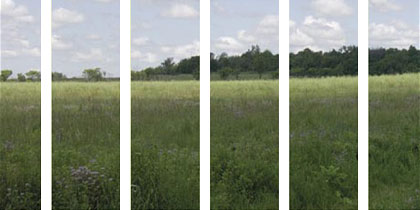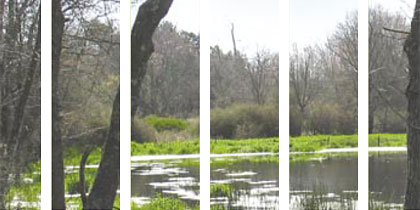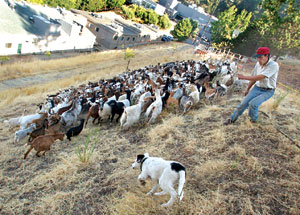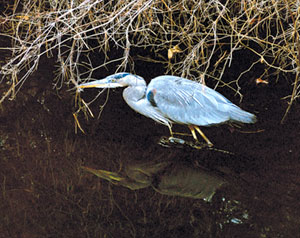Eco-science
by Elizabeth Wade
Many of the world's leading physics labs have concentrated on preserving and restoring their sites' unique ecosystems.
|
The country's first high-energy physics lab, Lawrence Berkeley National Laboratory, has adopted microorganisms as a key component in addressing environmental issues. Photo: Lawrence Berkeley National Laboratory |
 |
Stepping onto the site of a physics laboratory, you might expect to see enormous accelerators, ultra-powerful supercomputers, or scientists in lab coats racing between experiments. At one lab, however, what you will actually see are goats. At Lawrence Berkeley National Laboratory in Berkeley, California, goats roam through the hills, push over fences, and climb trees. They also provide the lab with an important service by munching on the brush that covers the area, helping to decrease the risk of a catastrophic wildfire in a natural and non-invasive way.
Berkeley is not the only physics laboratory to turn its sights toward the environment. With sites that can cover thousands of acres, many of the world's leading labs have concentrated on preserving and restoring their territories' unique ecosystems, while others use their scientific resources to do research that will benefit ecological programs across the world. As global warming heats up, fossil fuels run down, and protecting the environment becomes increasingly important, these labs remain on the forefront of both physics and ecology.
|
High-energy prairie
While Fermilab may not have goats, it does have buffalo. These American bison do not provide an ecological service in themselves; they are a reminder that Fermilab is not only the current home of the world's largest particle accelerator, but also of almost all of the Midwestern United States' major ecosystems—including oak savanna, agricultural fields, woodlands, grasslands, wetlands, and tall-grass prairie. Determined to protect and restore the lab's natural environment, Fermilab began its prairie reconstruction effort in 1975 with nine acres of land; today, the program includes 1200 acres of restored prairie. "Prairies have to be really large to be successful, especially because they are susceptible to invasion by non-native species," explains Rod Walton, environmental consultant for the lab and director of the Fermi National Environmental Research Park. Invasive, non-native species can destroy entire ecosystems by upsetting the balance of the environment and reducing ecological diversity, which is a key component in any sustainable ecosystem.
Listening to Mike Becker, manager of Fermilab's Roads and Grounds Department and encyclopedic source of information about the site's prairie, might convince you that Fermilab's prairie is already incredibly diverse, and indeed it is. Becker can point to each plant species in a flowering field and say what effect it has on the prairie, its relationship to the native animals, and what his team does to manage it. But in reality, Fermilab's ecosystems are still moving along the road to full diversity and sustainability, which will take generations. Currently, Becker is putting his knowledge to good use by doing an annual survey of plant species with his team, and adding enrichment seeds to increase diversity.
Ecological diversity is also a concern regarding Fermilab's pollinating insects, which range far beyond the butterflies that fly all over the site. Walton and Lederman Science Center docents Sue Sheehan and Dee Huie recently published a study of pollinating insects in Fermilab's prairie in the Chicago Wilderness Journal that indicates a surprising lack of diversity among the vital group. "The prairie is never going to be sustainable without pollinators," Huie says.
But even if all the right pollinators arrived on-site and non-native species stopped invading, Fermilab's ecological teams would not be able to completely walk away from the ecosystems they have reconstructed and created over the years. "We can never go back to what we had 150 years ago," Walton says. "We need to have a very active management strategy." Becker agrees, saying, "The environment will never be completely sustainable without our management. But with our management, it is already sustainable."
 |
Fermilab's 6800-acre site includes more than 1000 acres of restored prairie, with a complex and diverse ecosystem of native flora and fauna. Photo: Deborah Guzman Meyer, Fermilab |
New collider, new lake
Fermilab's priority is high-energy physics research, and that mission has sometimes conflicted with its ecological programs. For example, the lab was forced to destroy six acres of wetlands during the construction of the Main Injector in 1993. Shortly afterward, however, the lab successfully rebuilt 10 acres of wetlands inside the Main Injector's ring, confirming its commitment to uphold environmental standards under the United States' Clean Water Act, requiring the creation of 1.5 acres of wetlands for every acre that is destroyed. Another lab facing construction issues is CERN, which is currently building the Large Hadron Collider (LHC), an accelerator 27 kilometers in circumference, extending into both Switzerland and France.
A major goal in CERN's landscaping projects was to avoid the creation of artificial-looking sites, aiming to preserve the native environment as much as possible, even in the face of major construction. The existing forest around the Prévessin-Moëns technical area is being expanded; a lake is being created at the Cessy site, home of the Compact Muon Solenoid (CMS) Experiment, and the new buildings are being designed to minimize their visual and ecological impact. CERN has also made a concerted effort to limit the necessary construction by using infrastructure from the previous accelerator, LEP.
CERN, located on the border of France and Switzerland, has a unique environmental situation because "it behaves like a neutral state," says Sonja Kleiner of the lab's Integrated Safety Group. "CERN defines its own rules and regulations for environmental protection, based on European Directives and Host States regulations." The impact of CERN's activities on the surrounding environment is carefully tracked with a complete environmental monitoring program, which is defined and run in agreement with the authorities of Switzerland and France. The lab's day-to-day environmental protection efforts, however, are mostly based on common sense–even though the site doubles as a natural botanical reserve, home to the largest number of Ophyrys apifera Huds, a type of purple orchid, in the Lake Geneva region. "People are very respectful of the flowers and know how to protect them," Kleiner says.
|
A 13-year cleanup
Across the Atlantic lie the Pine Barrens of Long Island, New York, a rare ecosystem that includes both forests and wetlands. Adjacent to the Pine Barrens is Brookhaven National Laboratory, which in October 2005 announced the completion of a 13-year, US$353 million environmental restoration project at and near the Brookhaven site. The cleanup effort began with a 1992 agreement among the US Department of Energy, the US Environmental Protection Agency, and the New York State Department of Environmental Conservation. The scope of the work included soil and groundwater remediation, restoration connected with the Peconic River, and decommissioning projects at the Brookhaven Graphite Research Reactor.
Brookhaven's origins date back to 1946, when a consortium of nine major eastern US universities (Columbia, Cornell, Harvard, Johns Hopkins, Massachusetts Institute of Technology, Princeton, University of Pennsylvania, University of Rochester, and Yale) formed a nonprofit corporation to establish a new nuclear-science facility, sited on a surplus army base near Upton, Long Island, New York. In the years before many of today's environmental regulations were implemented, contaminants—mainly from the industrial solvents, heavy metals, and radioactive isotopes from the former hazardous waste treatment facilities on site—leached into the lab's soil and groundwater. As a result, Brookhaven was classified as a Superfund cleanup site in 1989. Officially known as the Comprehensive Environmental Response, Compensation and Liability Act (CERCLA), the Superfund sets aside money to clean up hazardous waste sites in the United States. CERCLA requires clean-up to include both short-term removal actions and more long-term remedial actions that reduce the risks associated with hazardous substances in the environment. The 13-year cleanup program has included building and operating 16 ground-water treatment systems on and off the site; cleaning more than eight billion gallons of groundwater; removing more than 5000 pounds of chemical contaminants from the aquifer; installing 3000 groundwater monitoring wells, and analyzing thousands of groundwater samples; restoring the Peconic River as an environmental, cultural, and recreational resource.
"The environmental program has been a priority at the laboratory for many years, and the support we've received from the Department of Energy helped make these accomplishments possible," says Brookhaven Lab Director Praveen Chaudhari. "I was also pleased to see so many in the broader community take a keen and positive interest in making this program a success."
Remaining is the long-term treatment of groundwater, with regular monitoring and reviews to ensure the ongoing results of the cleanup. The graphite reactor is scheduled to be completely decommissioned in 2007—all of it good news for Brookhaven and for its longstanding efforts on behalf of the Pine Barrens.
While the Pine Barrens have been protected for many years, their features, populations, and dynamics were not well understood. Brookhaven is an ideal place to study the ecosystem because "only about one-fourth of the site's 5000 acres have been developed," explains George Goode, manager of Brookhaven's Environmental & Waste Management Services Division. "Most of it is still in its natural state."
|
Peconic River after cleanup completion by Brookhaven National Laboratory near Upton, Long Island, New York. Photo: Brookhaven National Laboratory |
 |
The US Department of Energy recently designated 530 acres of Brookhaven's Pine Barrens as the Upton Ecological and Research Reserve, managed by the US Fish and Wildlife Service. Scientists from Brookhaven Lab and the Fish and Wildlife Service are using the reserve to study issues ranging from the life cycles of the marbled salamander, eastern hognosed snake, spotted turtles, and other native species to the impact of fire on the entire ecosystem. With dozens of wetlands on site, Brookhaven is also a key habitat for studying the endangered eastern tiger salamander and the site's dozens of aquatic invertebrate species. And with the cleanup, Brookhaven has enhanced the ecology of the site with native vegetation restored to many of the lab's surface areas. Wetland areas were restored specifically to ensure success of the eastern tiger salamander and banded sunfish.
Bacteria to the rescue
Many older labs are facing environmental issues. As the country's first high-energy physics laboratory, Berkeley Lab operated through many years of lax environmental regulations, and now, like Brookhaven, is looking at ways to clean up contamination. As a part of this effort, Berkeley has embraced a resource not many consider to be part of a cleaning process—bacteria. But far from being part of the contamination problem, Berkeley's microorganisms are a key component of its solution to its environmental troubles. The lab is on the forefront of microbial ecology, which examines how bacteria and other microbes affect ecosystems through their interactions with each other and with their surroundings.
|
Microbial ecology can be put to use as bioremediation, or the process of using microorganisms to restore a contaminated environment to its natural state. "We are currently working on a project where we are injecting carbon-13-labeled lactate into an aquifer at one of the biggest DOE sites in Hanford, Washington, where there is chromium-VI contamination," says Terry Hazen, head of Berkeley's Ecology Department. Unlike many other forms of chromium, chrom-VI is toxic—and, unfortunately, moves very easily into groundwater sources. "The lactate, which is food for the indigenous bacteria, will induce activity in bacteria that will reduce Chrom-VI to Chrom-III," a non-toxic form of the element that will not move into the groundwater, Hazen explains. "The carbon-13 label will allow us to trace what species are using the lactate and how fast, thus enabling better remediation techniques."
Berkeley Lab's ecological programs extend beyond managing and restoring DOE environments. "Our molecular microbiology work is linked to the genomics and nanotechnology research at the lab," Hazen explains. "We use the lab's Advanced Light Source's infrared beam to study how cells change in response to different contaminants." The data Berkeley Lab gathers from these types of experiments will be useful to all kinds of ecological programs around the world, because every ecosystem contains—and is often dependent on—its microbe population.
From prairie to Pine Barrens, high-energy physics laboratories are working not only to understand nature on its deepest level, but also to preserve its most beautiful forms for many generations to come.
Click here to download the pdf version of this article.









